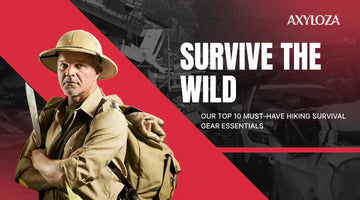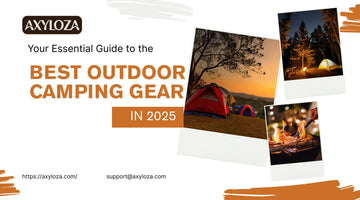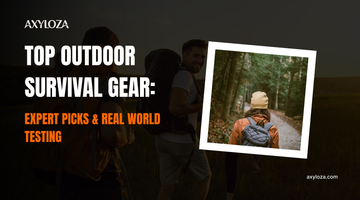When you head into the backcountry, hiking survival gear isn’t optional; it’s essential. From sudden storms to slippery trails, you’ll need gear that can save your skin, keep you warm, and help you find your way out.
Whether you're packing hiking and survival gear for a solo trek or putting together hiking gear for women or men in a mixed group, knowing what tools to bring matters. Let’s dive into the essentials so you're ready for anything.
What Hiking Survival Gear Do You Need?
Before you pick items, understand what type of risks you might face: bad weather, injury, getting lost, getting cold, and dehydration. These define what your essential hiking gear should cover: shelter, warmth, water, food, navigation, safety, and light.
Many hikers refer to the “Ten Essentials” as a baseline, so you’re prepared for surprises. These are the items you shouldn’t leave behind if you expect the unexpected.
Top 10 Must‑Have Hiking Survival Gear Essentials

1. Reliable Shelter & Warmth
A lightweight tent or emergency tarp and sleeping bag rated for expected temps. Even in summer, nights can drop fast. A waterproof shell, insulation layers, and an emergency blanket help you stay safe. Shelter is your shield from cold and the weather. For reliable options, check out Axyloza’s camping tents collection and sleeping bags designed for durability and packability.
2. Water & Purification Tools
Hydration is survival. Carry sufficient water capacity plus a backup purification: portable water filters or purification tablets. They must work reliably and fast.
3. Fire Starters & Light
You need fire to boil water, keep warm, signal, or just stay safe when night falls. Waterproof matches, a lighter, a ferro rod or fire steel, all are good options. Pair with a headlamp or flashlight with spare batteries so you’re not stumbling in the dark.
Explore Axyloza’s LED lamps collection for high-quality lighting gear perfect for hiking and camping.
4. First Aid & Health Supplies
Scrapes, cuts, bug bites, and blisters can derail a hike if left untreated. A compact first aid kit for hikers should include bandages, antiseptics, tweezers, pain relievers, blister pads, and any personal meds.
5. Navigation & Signaling
Maps and compasses remain ever-reliable; phones and GPS devices fail without a battery or signal. Add a whistle, signal mirror, or beacon in remote areas. Being seen or heard can save lives more than having fancy tech.
6. Tools & Repair Kit
Multi-tools or knives, ropes, fabric patches, duct tape: to fix gear, build shelter, and craft things you need on the trail. Even simple tools can cover a huge range of tasks in survival scenarios.
7. Food & Energy Supplies
High‑calorie snacks, trail mix, energy bars, and dehydrated meals. Must be easy to prepare and carry. Have enough food so you’re never caught with low energy. Hunger saps strength quickly.
8. Headlamp / Flashlight & Power
A reliable headlamp frees your hands; a backup flashlight helps navigate after dark. Carry spare batteries or a power bank. Solar chargers are nice if you expect longer trips off the grid or unreliable resupply.
Consider pairing your gear with Axyloza’s handy Bluetooth speaker and charger collection for on-the-go power and entertainment.
9. Proper Backpack & Carry System
The right pack makes everything comfortable. Size, weight distribution, and durability matter. Pack with compartments so you can access essentials quickly. The weight of the pack plus gear should be manageable for your distance.
Browse Axyloza’s wide range of backpacks suited for all hiking needs, lightweight, durable, and designed for comfort.
10. Clothing Layers & Rain Protection
Even when starting with sunny skies, the weather can change fast. Waterproof hiking gear, warm insulating pieces, moisture‑wicking base layers. For women’s hiking gear or men’s hiking gear, proper fit is important to avoid chafing and heat loss.
Order Today: Electric Bike
What Gear Features Matter Most?

It’s not just what you bring, it’s which version. Here are qualities to prioritize in your hiking survival gear kit:
- Lightweight vs durability: gear that saves grams but holds up under rain, rocks, and scrapes.
- Packability & compactness: shelter that packs small, tools with multi‑use, sleeping bags that compress.
- Waterproofing/weather resistance: rain shell, tarp, waterproof cover, gear with sealed seams.
- Quality of materials: strong zippers, tough fabrics, corrosion‑resistant metals.
- Ergonomics for fit: backpacks that settle on your hips, boots that support ankles; clothing that moves.
Gender & Use‑Case Specifics
Choosing hiking gear for women or hiking gear for men often boils down to fit, proportion, and sometimes style, but the survival essentials remain the same.
- Women’s packs often have better suited torso lengths, hip belts, and strap configurations.
- Men’s hiking gear may have roomy sizing or cut differences.
-
All should have the same core survival tools.
Also, think about a day hike vs a multi‑day trek, budget vs premium, ultralight vs comfort. Adapt your gear list accordingly.
Product Details
Here are the benefits & specs you should aim for in your gear:
- Rugged, weather‑proof materials with sealed seams and water resistance
- Lightweight design (packable tents, compressible sleeping bags) without sacrificing warmth or protection
- Multi‑functional tools that reduce the number of separate items needed (knife + multi‑tool, light + power bank, etc.)
- Reliable emergency tools: headlamp with long battery life, emergency blanket or tarp, fire starter that works when wet
- Proper fit & comfort: backpacks with adjustable suspension, clothing, and footwear suitable for terrain and climate
You Can Also Explore:
Ultimate Adventure Outdoor Gear Guide: Essentials for Every Journey
Top Outdoor Survival Gear: Expert Picks & Real World Testing
Hiking Gear Checklist: 10 Essentials at a Glance
Here’s a table summarizing essentials for quick review when packing your hiking survival gear.
Hiking Survival Gear Essentials Table
|
Essential Item |
Why It Matters |
|
|
1 |
Shelter & Warmth (tent/tarp/emergency blanket) |
Protects from exposure and bad weather |
|
2 |
Water & Purification Tools |
Prevents dehydration & waterborne illness |
|
3 |
Fire Starter + Flame Tools |
Warmth, cooking, signal, safety |
|
4 |
First Aid Kit |
Handles injuries early before complications |
|
5 |
Navigation & Signaling Tools |
Avoid getting lost, help others find you |
|
6 |
Multi‑Tool / Knife & Repair Kit |
Versatile fixes & survival construction |
|
7 |
Food & Energy-Dense Supplies |
Keeps energy up during strenuous activity |
|
8 |
Lighting + Power Source |
Visibility & operations after dark |
|
9 |
Backpack Fit & Load System |
Comfort, mobility, weight distribution |
|
10 |
Clothing Layers & Rain Protection |
Adaptive to weather changes & moisture control |
Why Is It Important to Carry Survival Gear When Hiking?
Carrying the right survival gear isn’t about being paranoid. It’s about being realistic. Trails get twisted. Storms show up. Injuries happen. Phones die. Being prepared means safety, not fear.
- Good hiking survival gear can save your life in emergencies.
- Reduces risks of hypothermia, dehydration, and infection.
-
Enables self‑sufficiency so you’re less dependent on rescue.
It’s like carrying insurance in your pack; mostly you won’t need it, but if you do, you’ll be glad it’s there.
Shop Now: Backpack
How Much Gear Should You Carry? Day Hike vs Multi‑Day Trek
What you pack depends on the trip duration.
- Day hike: lighter backpack, basics: hydration, snacks, first aid, light layer, navigation, headlamp. Keep the load minimal.
-
Overnight / multi‑day: add shelter (tent or tarp), full sleeping system, extra food, water purification, backups for light & navigation, more robust gear.
Balance weight vs necessity. For a multi‑day trek you’ll naturally carry more, but pick gear that offers versatility and low weight.
Conclusion
You deserve gear that won’t quit when things get hard. Build your ultimate hiking survival gear setup now. Browse rugged packs, shelters, emergency tools, and essentials at Axyloza’s hiking gear collections and make your next adventure safe, prepared, and unforgettable. Start exploring the backpacks, camping tents, and LED lamps today!
FAQs
How to choose the best survival gear for hiking?
Focus first on the conditions you expect, weather, terrain, and duration. Prioritize shelter, water, fire, navigation. Then select gear that offers durability, good weight, packability, and fit. Test your gear before relying on it out there.
What gear can help me survive unexpected emergencies on the trail?
Carry an emergency blanket or bivy sack, fire starter (like ferro rod or lighter), first aid kit, map & compass or GPS backup, whistle or signal mirror, and a reliable headlamp. These tools often make the biggest difference in emergencies.
What are the top 10 must‑have hiking survival gear essentials?
Shelter & warmth; water & purification; fire & lighting; first aid; navigation & signaling; tools & repair kit; food & energy; backpack & carry system; clothing layers & rain protection; and gear fit + durability.
How much survival gear should you carry for a day hike vs a multi‑day trek?
For day hikes, carry essentials only: water, snacks, protection from weather, navigation, light, basic first aid. On multi‑day treks, add full shelter, extra food, backup navigation/power sources, more gear for weather, and emergency gear.
Why is it important for a hiking survival gear list to include durable tools and navigation?
Because when things go wrong, weather hits, trails shift, roads vanish, you can’t rely on convenience or aesthetics. Durable tools and reliable navigation gear are what keep you safe; they outlast flash, out‑perform looks.



